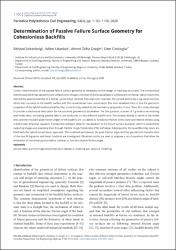| dc.contributor.author | Soltanbeigi, Behzad | |
| dc.contributor.author | Altunbaş, Adlen | |
| dc.contributor.author | Gezgin, Ahmet Talha | |
| dc.contributor.author | Çinicioğlu, Özer | |
| dc.date.accessioned | 2020-12-16T07:20:00Z | |
| dc.date.available | 2020-12-16T07:20:00Z | |
| dc.date.issued | 2020 | en_US |
| dc.identifier.citation | Soltanbeigi, B., Altunbaş, A., Gezgin, A. T. ve Çinicioğlu, Ö. (2020). Determination of passive failure surface geometry for cohesionless backfills. Periodica Polytechnica Civil Engineering, 64(4), 1100-1110. https://dx.doi.org/10.3311/PPci.14241 | en_US |
| dc.identifier.issn | 0553-6626 | |
| dc.identifier.uri | https://dx.doi.org/10.3311/PPci.14241 | |
| dc.identifier.uri | https://hdl.handle.net/20.500.12511/6088 | |
| dc.description.abstract | Correct determination of the passive failure surface geometry is necessary for the design of retaining structures. The conventional theories assume linear passive failure surfaces even though it is known that the actual failure surfaces are non-linear. Many researchers claimed the appropriateness of a hybrid curved-linear method. This approach estimates the curved section by a log-spiral function, which then connects to the backfill surface with the conventional linear assumption. The main drawback here is that the geometric properties of the hybrid mathematical function is not directly related to the mechanical properties of soils. Thus, this study attempts to provide a mechanical description for the assumed geometrical parameters. For this purpose, a series of 1 g small scale retaining wall model tests, simulating passive failure, are conducted on two different backfill soils. The relative density is varied in the model tests and the resultant peak friction angles of the backfills are calculated as functions of failure stress state and relative density using a well-known empirical equation. Transparent sidewalls allow for visualization of the failure surface evolution, which is obtained by capturing images and analysing then through Particle Image Velocimetry (PIV) technique. Subsequently, the quantified slip zones are fitted with the hybrid curved-linear approach. The relationships between the peak friction angle and the geometrical characteristics of the best-fit log-spiral and linear functions are investigated. Obtained results are used to propose a set of equations that allow the estimation of non-linear passive failure surfaces as function of peak friction angle. | en_US |
| dc.language.iso | eng | en_US |
| dc.publisher | Budapest University of Technology and Economics | en_US |
| dc.rights | info:eu-repo/semantics/openAccess | en_US |
| dc.subject | Passive State | en_US |
| dc.subject | Particle Image Velocimetry (Piv) | en_US |
| dc.subject | Dilatancy | en_US |
| dc.subject | Retaining Wall | en_US |
| dc.subject | Physical Modelling | en_US |
| dc.title | Determination of passive failure surface geometry for cohesionless backfills | en_US |
| dc.type | article | en_US |
| dc.relation.ispartof | Periodica Polytechnica Civil Engineering | en_US |
| dc.department | İstanbul Medipol Üniversitesi, Mühendislik ve Doğa Bilimleri Fakültesi, İnşaat Mühendisliği Bölümü | en_US |
| dc.authorid | 0000-0003-4235-8310 | en_US |
| dc.identifier.volume | 64 | en_US |
| dc.identifier.issue | 4 | en_US |
| dc.identifier.startpage | 1100 | en_US |
| dc.identifier.endpage | 1110 | en_US |
| dc.relation.tubitak | info:eu-repo/grantAgreement/TUBITAK/SOBAG/114M329 | |
| dc.relation.publicationcategory | Makale - Uluslararası Hakemli Dergi - Kurum Öğretim Elemanı | en_US |
| dc.identifier.doi | 10.3311/PPci.14241 | en_US |
| dc.identifier.wosquality | Q4 | en_US |
| dc.identifier.scopusquality | Q3 | en_US |


















